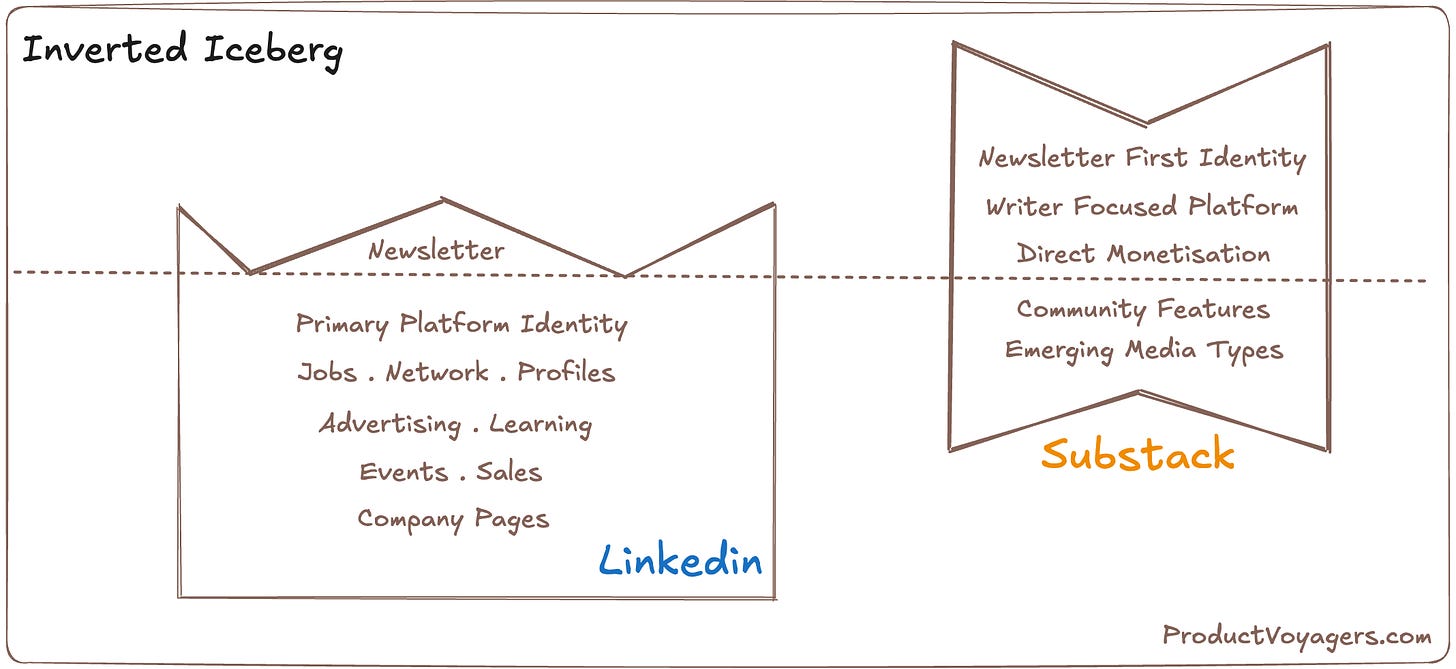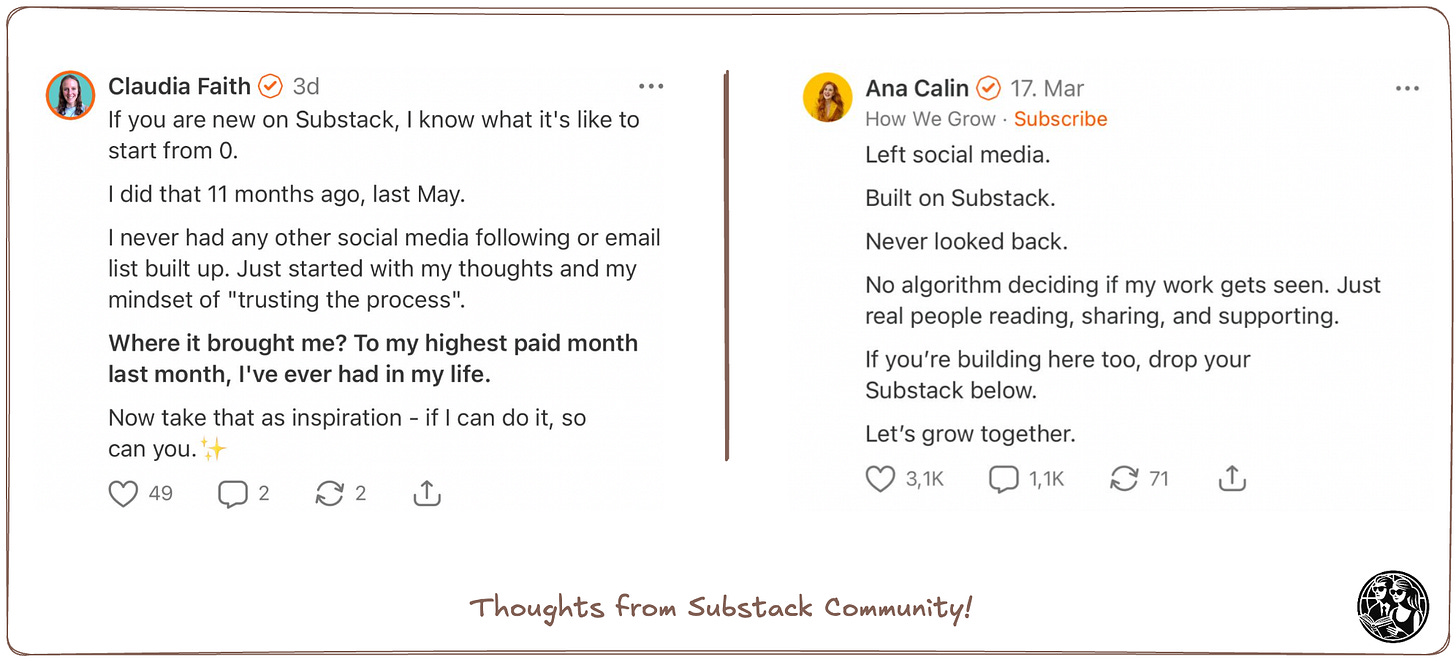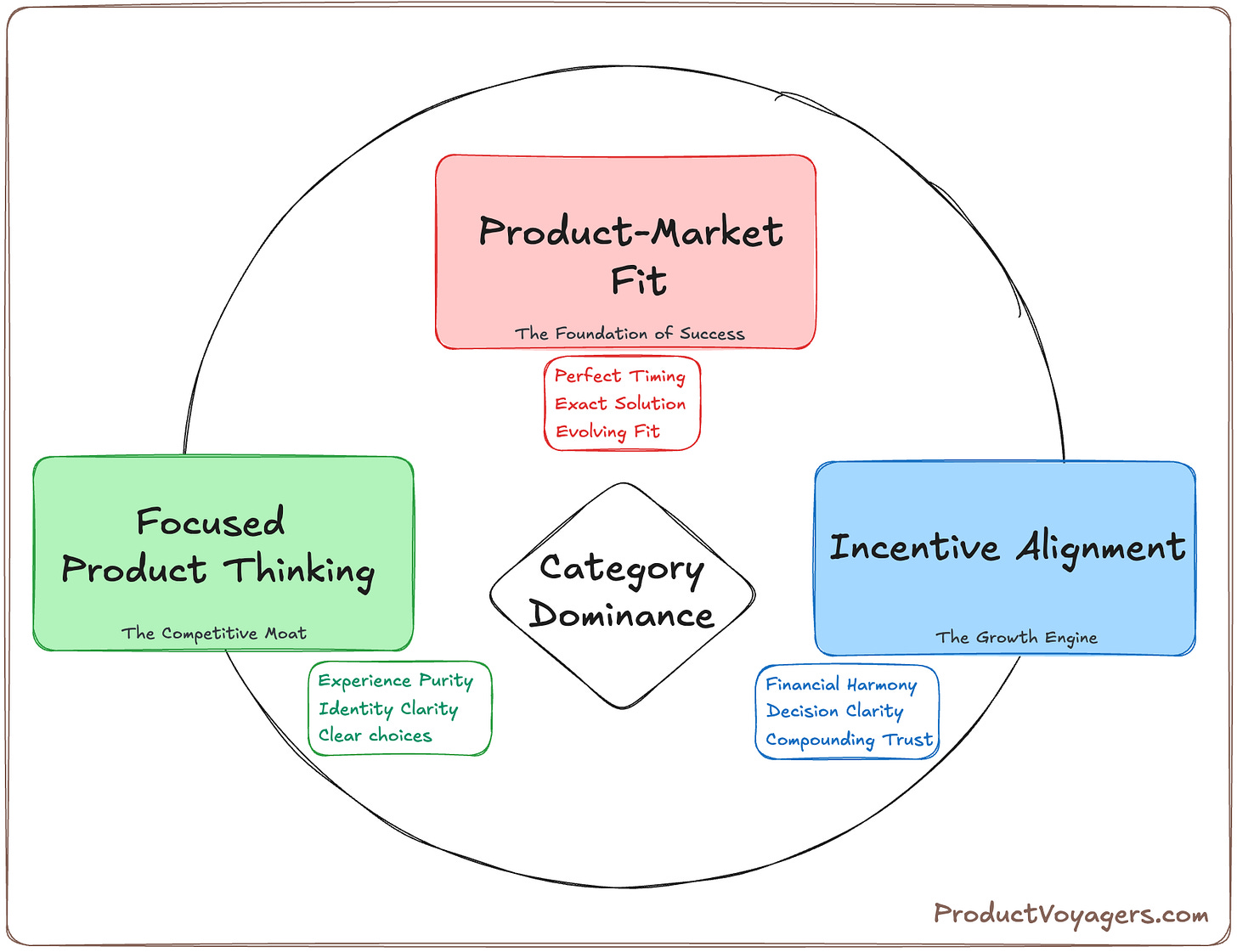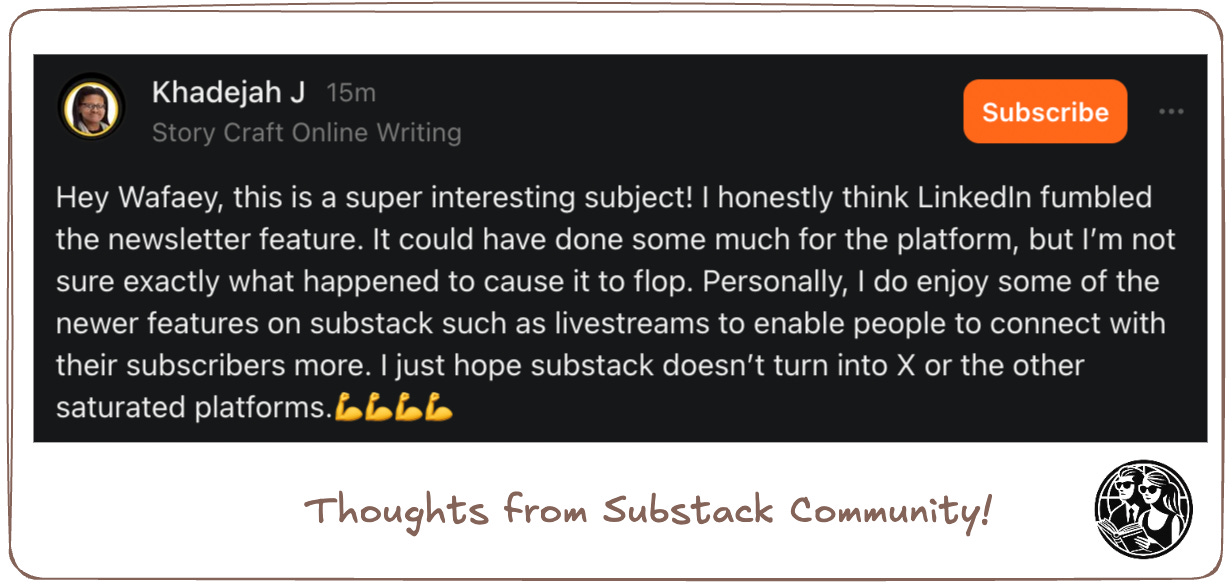Why Substack Won the Newsletter War!
A Product Strategy Masterclass In Focus, Alignment, and Product-Market Fit.
Welcome to Toasted Product Thinking series — where we break down great products to spotlight what’s brilliant, what’s overcooked, and what needs a better recipe.
This is a free edition of The Product Voyagers.To unlock full playbooks, tools, templates and expert takes — go Prime.
LinkedIn had the head start.
With over 1 billion users, it launched newsletters years before Substack even existed.
Substack entered late, as the underdog, with nearly identical core features.
Yet today, Substack is a $650M publishing empire—synonymous with independence—while LinkedIn’s newsletter tool remains an afterthought.
This isn’t just a case of better UX.
This case study reveals profound lessons about 1/ product-market fit, 2/ incentive alignment, and the power of 3/ focused product thinking.
What you’ll learn in this deep dive:
Why Substack won: timing, execution, and the Inverted Iceberg model
5 product lessons + 3 strategic pillars you can apply today
The Expansion Paradox: how success can erode identity
"Inverted Iceberg" Mental Model
To understand how Substack pulled ahead, let’s start with a simple mental model: Inverted Iceberg.
When a large platform adds a feature, it stays buried under everything else the platform does.
But when a dedicated product focuses entirely on one thing—and does it exceptionally—it rises above.
Beyond Features: The Timing and Execution Advantage
While the Inverted Iceberg model explains Substack’s structural edge, it’s crucial to recognize that feature parity never decides the outcome. Timing and execution do.
Substack didn’t just launch the right product—it launched at the right moment.
Between 2014 and 2019, couple of major shifts created the perfect storm:
33,000 newspaper jobs vanished—a 25% drop—freeing up a wave of writers.
In 2017 alone, over 3,000 journalist jobs were cut—the same year Substack launched.
The creator economy exploded, growing from $1.7B (2016) to $6.5B (2019).
Facebook’s algorithm update in 2018 slashed publisher reach by 34%, fueling platform disillusionment.
Email surged back—open rates rose 14% (2016–2018), with Americans spending 143 minutes/day in their inbox.
And critically, consumer subscription willingness nearly doubled: from 9% in 2016 to 16% in 2019.
By mid-2020, Substack had 100,000+ paying subscribers, and top writers were earning $150K+ annually—proof that the model worked.
LinkedIn? It added newsletters as a defensive move.
By 2022, they’d amassed 150 million newsletter subscribers, yet open rates sat below 15%—well under the standards of a platform built for writing.
And to really understand why—it’s time to zoom in on the six forces that made all the difference: Business, Product, Design, Culture, Monetization, and Distribution.
#01 Business: Goal Alignment vs. Divided Attention
LinkedIn's Misaligned Incentives
Newsletters were never core to LinkedIn’s business. Their main revenue drivers—recruitment, ads, and subscriptions—relied on users doing something else entirely. Time spent reading meant time not spent clicking, applying, or networking.
So newsletters became a defensive feature. Not a strategic bet, just a way to keep people on the platform. And it showed—in the half-hearted product, unclear positioning, and lack of evolution.
Substack's Perfect Alignment
Substack was all in. It only makes money when writers do—taking a simple cut of subscription revenue.
That kind of alignment sharpens every decision. No competing priorities. No internal turf wars. Just a clear, shared goal: help writers succeed.
Where LinkedIn had to juggle business lines, Substack focused on one thing: make newsletters work—financially, creatively, and operationally.
When creators win, the platform wins. That kind of trust can’t be bolted on.
#02 Product: Purpose-Built vs. Bolted-On
LinkedIn's Product Shortcomings
LinkedIn’s approach to newsletters highlights the pitfalls of bolting a feature onto an already crowded platform. Users often couldn’t tell if they were reading a post, an article, or a newsletter—the lines were blurry, and that lack of clarity reduced the perceived value of the content.
This confusion extended to the broader experience. A reader trying to focus on a newsletter might be interrupted by connection requests, job alerts, or promotional messages. The cognitive overload made it hard for thoughtful writing to land.
Even LinkedIn's most successful newsletters like "The Rundown" by Sherrell Dorsey or "Big Technology" by Alex Kantrowitz struggle with these limitations. Despite quality content, they're presented in a way that often feels indistinguishable from promotional content or maybe a spam!
Substack's Product Advantages
Substack took a different path—designing a purpose-built experience centered on the relationship between writer and reader. Its clean, focused environment removed distractions, allowing readers to engage deeply with the content.
By prioritizing email delivery, Substack met readers where they already were: their inbox. No platform-switching, no new habits—just direct, uninterrupted access to writing that mattered.
Crucially, the platform also freed writers from professional constraints. Without worrying about how their content might affect job prospects or public image, they could explore new voices, topics, and formats. That creative freedom fostered a level of authenticity rarely found in LinkedIn’s buttoned-up atmosphere.
Features compete for attention. Purpose-built products earn it.
#03 Design: Intentional Space vs. Crowded Real Estate
LinkedIn's Design Problems
LinkedIn’s newsletter feature never felt special—because it wasn’t designed to be. It was buried inside a noisy feed, competing with ads, job alerts, connection requests, and promotional posts. Every screen element pulled focus away from the content itself.
The platform’s visual language—dense, corporate, utilitarian—treated newsletters like just another piece of professional noise. Even thoughtful writing struggled to stand out, often indistinguishable from marketing updates or branded content.
Substack's Design Strengths
Substack did the opposite. It created a calm, dedicated space for writing and reading. The design was minimal, purposeful, and quiet—signaling clearly: “This is about the words.”
It also gave writers room to build a brand: mastheads, typography, and visual identity tools helped each publication feel distinct and personal.
Crucially, Substack optimized for where readers already are—the inbox. Its consistent email-native experience made subscribing, reading, and staying engaged seamless across formats. I’m
Great content needs space to breathe. Substack gave it room. LinkedIn gave it noise.
#04 Cultural: Community vs. Corporation
LinkedIn's Cultural Mismatch
At its core, LinkedIn is a platform for professional reputation management. Its culture is formal, filtered, and cautious—optimized for resumes, not raw voices - “Wear-a-tie”.
That environment isn’t built for the kind of writing newsletters thrive on. When creativity is filtered through the lens of professional image, authenticity suffers.
Writers on LinkedIn also faced a constant friction: algorithm opacity. No one knew how their content was being distributed or why. And even when a newsletter found traction, the credit still belonged to the platform. You didn’t build a brand—you built engagement on LinkedIn.
This corporate dominance prevented writers from building personal connection with readers—the lifeblood of successful newsletters.
Substack Got the Culture Right
Substack approached culture differently from day one. Writers weren’t just users—they were the product, the brand, the stars.
The platform amplified them, not itself. Through leaderboards, features, and curated recommendations, it elevated voices instead of burying them in feeds. That mattered.
But Substack’s biggest cultural unlock was something subtle: small pond effect.
On LinkedIn, even top-tier writers are tiny fish in an enormous ecosystem of influencers, job posts, and corporate chatter. Visibility is rare. Recognition is diluted.
But on Substack, the ecosystem is tighter, more focused. A good writer with a clear voice can gain visibility fast—building not just an audience, but a reputation.
This status shift is powerful. For many creative professionals, the ability to build a distinctive identity and be seen as a category leader matters more than incremental features or short-term monetization. Substack understood that. LinkedIn didn’t.
Substack didn’t just build publishing tools but it built an environment where writers could stand out, feel ownership, and grow with purpose.
Platforms can give you tools, but only culture gives you voice. Substack built a space where writers don’t just publish—they belong.
#05 Monetization: Direct vs. Indirect
LinkedIn's Monetization Dilemma
LinkedIn's foray into newsletters was primarily aimed at boosting platform engagement, rather than generating direct revenue. This approach inadvertently diverted user attention away from LinkedIn's primary income streams:
Recruitment Services: Approximately 65% of LinkedIn's revenue.
Advertising: Around 25% of revenue.
Premium Subscriptions: Contributing about 10% of revenue.
This misalignment led to newsletters being underprioritized, resulting in sluggish feature development and limited innovation. As a publicly traded company, LinkedIn was also constrained in experimenting with monetization strategies that might jeopardize its core revenue channels.
Substack's Monetization Clarity
In stark contrast, Substack's business model is straightforward:
Revenue Model: Substack takes a 10% commission from writers' subscription earnings.
This direct approach ensures that Substack's success is intrinsically linked to the success of its writers. By 2024, Substack achieved significant milestones:
Paid Subscriptions: Surpassed 3 million, up from 2 million the previous year.
Active Subscriptions: Over 35 million active subscriptions on the platform.
Top Publishers' Earnings: The top 10 publishers collectively earned over $25 million annually.
Total Writer Payouts: Readers have paid writers more than $300 million through Substack subscriptions.
... aligned monetization strategy has empowered writers to generate substantial income, with top publications earning millions annually.
#06 Distribution: Focused vs. Fragmented
LinkedIn’s Newsletter Problem? Distribution.
Despite its massive user base, LinkedIn’s algorithm wasn’t built for newsletters. It prioritized engagement signals—likes, comments, profile data—not content quality or reader relevance. Great writing often got buried.
And newsletters had to compete in a chaotic feed—crowded with short posts, videos, ads, and sponsored updates. In that noise, long-form content barely stood a chance.
Discovery was another bottleneck. Newsletters lived inside LinkedIn’s walled garden—only visible to users already in the ecosystem and actively searching. That stifled organic growth and killed any meaningful network effects.
Substack Took the Opposite Path. And It Worked.
Substack bet on the inbox. Email gave writers a direct line to their readers—no algorithm, no gatekeepers, no feed fatigue.
They also unlocked peer discovery. Writer-to-writer recommendations powered authentic growth, fueled by trust—not clicks.
And they embraced openness. With SEO-optimized pages and public links, content could travel freely across the web—through search, social shares, and beyond. LinkedIn never allowed that.
In the end, LinkedIn had the scale—but Substack had the signal.
... Feeds chase attention. Inboxes build connection. Substack won by delivering where it matters most.
🎯 Lessons for Product Leaders
So what can Product Leaders actually learn from this?
This showdown Substack vs. LinkedIn isn’t just a story about platforms. It’s a masterclass in product leadership—especially when building focused products inside complex organizations. Let’s get into the five enduring lessons.
1. Focus Beats Feature
A dedicated product that goes deep will almost always outperform a shallow feature inside a bigger platform.
Substack didn’t win with more engineers, funding, or distribution.
It won by doing one thing exceptionally well—while LinkedIn spread attention across everything else.
Focus. They didn’t try to be everything. Just a great newsletter platform, done really well. Depth over breadth
Depth wins where breadth gets diluted.
2. Incentive Alignment Is Non-Negotiable
Substack only makes money when its writers make money. That’s not just elegant—it’s powerful.
When platform incentives mirror user success, product decisions become obvious, prioritization becomes clear, and growth becomes self-reinforcing.
Writers first. Instead of chasing scale, they personally onboarded top writers—offering advances, support, and visibility. Those writers brought credibility and momentum.
When users win, the business wins. That’s how you scale with trust.
3. Clarity Creates Gravity
People don’t just adopt tools—they join identities.
“Substack writer” means something. It signals independence, creativity, ownership.
“LinkedIn newsletter publisher” feels like a feature checkbox.
Status matters. Substack made writers feel seen—through leaderboards, features, and recommendations. It wasn’t just tools; it was recognition.
Clear identity attracts loyalty. Ambiguous positioning attracts churn.
4. Experience Purity Drives Retention
Substack eliminated distractions. LinkedIn introduced them.
In a world of endless tabs, pings, and feeds, clean, focused experiences are a competitive advantage—especially for high-attention products like newsletters, long-form content, or learning.
Community over competition. Writers weren’t just publishing—they were connecting, cross-promoting, and growing together. Substack quietly built a network, not just a platform.
The fewer context switches, the more people stay.
5. Culture Is the Hidden Platform
Substack didn’t win because its editor or analytics were better.
It won because it built a culture where writers were celebrated, not buried.
That culture shaped behavior, brand, and belief.
A story that sticks. Their narrative wasn’t "email made easy." It was "independence from the algorithm." That mission gave writers a reason to believe.
If product is what people use, culture is what keeps them coming back.
The Three Pillars in Action
Ending where we began. This battle (Substack vs. LinkedIn) teaches us that product success rarely comes from features alone—it emerges from the harmonious alignment of three fundamental pillars:
This isn’t just a framework—it’s the reality behind every enduring product.
Substack didn’t win on features.
It won on fit. On focus. On alignment.And that’s how you build for category dominance
👀 What’s Next?
Substack won with clarity, right? But now, success is pulling it in new directions—live video, short reels, community, social feeds. Is it becoming what it once disrupted?
That leads to a well-known Platform Expansion Paradox
How growth can blur identity—and why every focused product eventually hits a fork in the road:
(a) The LinkedIn Path — Newsletters become just another tab. A sharper, more focused rival rises.
(b) An Evolutionary Win — Substack expands wisely, keeping newsletters at its center of gravity.
(c) A Strategic Retreat — The team cuts through the noise and doubles down on what made it magical to begin with.
This next chapter is already stirring conversations—and the whole community is watching closely to see what happens next.
Attention:
As product builders, founders, and strategists, it’s worth keeping a close eye. The next Inverted Iceberg play might be someone turning it on Substack—just like Substack once did to LinkedIn.
🎁 So, want the 1-Page Cheat Sheet?
Read it. Loved it. Now make it stick.
I'm turning this article into a 1-page cheat sheet with:
🧊 The Inverted Iceberg Model
🧠 5 Product Strategy Lessons
⚙️ The 6 Forces Behind Substack’s Advantage
✅ Key prompts to guide your next product decision
✨ Exclusively for Prime Voyagers.
🙏 People Who Made This Piece Better
This piece was shaped by the insights, screenshots, and sparks shared by brilliant minds across the product and creator space. Special thanks to:
, , , , , and — your posts helped shape the narrative, the laughs, and the lessons.

















Thank you for including me! Appreciate it. :) And great post! Still feel that LinkedIn's newsletter feature is kind of spammy and Substack is the place to be.
Amazing, thank you for citing me AND my doodle! We’re both feeling very seen and dangerously close to printing this out and framing it!
This is such a powerful, timely and relevant post. I really appreciate your analysis, and the whole idea behind this series. I’ll be here for the next chapters.
Substack feels like writers were in the room when it was built, look:
It gave us narrative, a villain (algorithms), a hero (authenticity), and a plot twist (monetization).